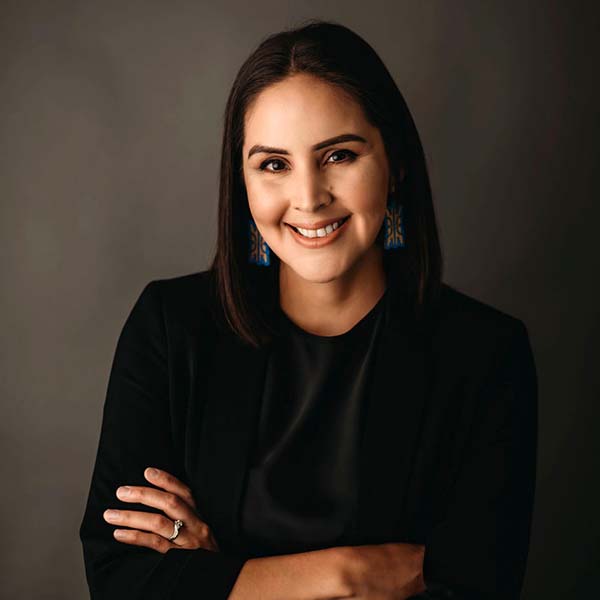For the first time in the six-year history of the Wisconsin Indian Business Alliance, the coalition of four Native community development financial institutions will have a new chair.

Pamela Boivin, executive director of Keshena, Wis.-based NiiJii Capital Partners Inc., was elected to serve as chair of the board of directors at WIBA, a unique collaborative of the four Native CDFIs in the state of Wisconsin. In addition to NiiJii Capital, the members of the alliance include Lac du Flambeau-based Wisconsin Native Loan Fund, Black River Falls-based First Nations Community Financial and Hales Corners-based First American Capital Corporation.
Boivin replaces founding member Fern Orie, a board member and founding CEO at Wisconsin Native Loan Fund who last week was appointed chief programs officer and executive vice president of advocacy and strategic partnerships at Longmont, Colo.-based Oweesta Corp., an intermediary for Native CDFIs.
Want more news like this? Get the free weekly newsletter.
A member of the Menominee Indian Tribe of Wisconsin, Boivin expects WIBA to continue on without missing a beat, particularly given the high level of participation among all four member organizations. She spoke with Tribal Business News about the role Native CDFIs play in helping tribal economies recover from the pandemic, as well as why she thinks now is “absolutely” a good time for Native Americans to embrace entrepreneurship.
As you step into the role of chair of WIBA, how do you assess the effectiveness of the alliance?
We’re all equally contributing members, we all strive for the same mission. It’s been a long-standing group. Our establishment as the Wisconsin Indian Business Alliance was formalized in early 2015, but this group of people had been collaborating for long before that — it started in 2009. So we have a good history, and we have a good knowledge of our individual organizations. It’s bringing our best strengths together and lifting where we need to be lifted and empowering the strengths and (addressing) weaknesses. Building the best collaboration has always been the motivating force behind us all.
Talk about the work Fern Orie has put in as chair since WIBA’s inception in 2015.
Fern is such a strong and down-to-earth leader. There’s so many elements about her that her leadership elevated WIBA to where we are today, with everybody’s individual contributions. Fern really is one of those Level 5 leaders who established the culture of our alliance. That made this a nice-oiled machine. Going forward, we still take that same motivation and continue those missions and objectives that we’ve been working on since our inception as a group.
Bringing together four separate organizations with their individual boards and missions has to come with its share of challenges. What has made the alliance successful over the years?
Back in 2009 when we were kind of working in our own little silos and deploying our loans products and doing our technical assistance, we started to see that there was some overlap. Since a lot of us cover similar target markets, we were realizing, ‘Oh, hey, we were just offering this type of training. How did yours go? What is something that we could do different to better serve our clients?’ It started with those tiny reach outs.
The more we started reaching out, the more we realized this one organization, for instance, does really well at delivering the best (technical assistance) around this specific topic. Let’s bring them in so that we can get this particular business or this particular client the most efficient services. We started piecing those together, and it built off of those collaborations into, ‘Let’s combine and do a workshop together.’ And then the workshops evolved into collaborating on combined efforts and seeking additional resources that we wouldn’t necessarily be eligible for or consider as an individual organization.
It blossomed from those small pieces, those small steps. The ultimate goal was always: How do we better serve our clients and our target markets? Weighing in off of those strengths and identifying where some of the weaknesses are in our individual organizations kind of pulled us all together.
What’s your philosophy in chairing the alliance?
One of the beautiful things I love about the alliance is that it’s not particularly a single person driven organization. Each member contributes a ton and a wealth of information to the alliance itself. As a new leader, I definitely want to keep the ‘we’ in the team. With the shifts that are going to occur coming out of the pandemic and what that looks like for our clients, I think we’re all going to need to be on our toes. Collaboration is going to be needed now more than ever.
It seems like the forces are aligning to recognize the roles that CDFIs play in reaching underserved communities. How do you see this playing out?
CDFIs were recognized as these beacons of light in the pandemic. Conventional banks weren’t able to reach the populations or the markets that we were able to reach, and that’s where a lot of the relief needed to be. It was very evident in the pandemic that CDFIs are important, more so now, so that we can get these communities and businesses the assistance they need and work on rebuilding our tribal economies.
With historic levels of federal investment in Indian Country, are WIBA’s needs purely financial or do you need additional resources for training and education?
Training is crucial. That’s the driving force of our loans and our products that we deploy to our target markets. Most of our organizations in the alliance really put a heavy weight on the pre-technical assistance, and that’s a time crunch right there when you’re dealing with a client. It’s making sure we have an established client or business in order to take on the financing and set them up for success, rather than just deploying these funds. It’s very heavy on technical assistance, pre-loan. It’s the financial literacy pieces.
Talk about why the process needs so much technical assistance and upfront training.
We’re really taking on clients that are unbankable, so to speak. How do we get them to that point to be bankable businesses? That’s a success story for us and that’s the ultimate (goal) for our clients. We don’t want to be their long-standing solution. We’re hoping that we build them up so that they are eligible to get a loan at a conventional banking institution.
How does that affect your staffing needs?
In order for us to deliver that heavy pre-(loan) technical assistance and that post technical assistance to ensure that the clients that we finance are continuing … their individual financial sovereignty journey, our organizations need the operations to build our services and to increase our staff so we can do more of that hands-on technical assistance. Whereas, when we’re doing the technical assistance, we’re wearing multiple hats. But if we want to elevate that delivery, to be able to reach more within our target market, we’ll always be searching for those additional funds to make sure that happens so that we’re creating the jobs and empowering that financial sovereignty.
Are there any non-traditional partners coming to the table or new sources of investment coming to the table?
When CDFIs were identified as these beacons of hope during the pandemic, a lot of investors and a lot of foundations were really inspired by that. So, we have been contacted by a diverse amount of investors because of the output and because of the impacts that we have. The diversity of that has expanded, and we’ve definitely been solicited quite a bit for input to help other organizations to develop products and programs and grant opportunities to deliver for the underserved markets. It’s kind of a two-way street. We’ve been equally putting out there the needs and some of the things that would help trickle down to our tribal economies.
How are WIBA members adapting to the new influx of capital aimed at helping mitigate the effects of the pandemic in Native communities?
The new money that’s coming in is definitely helpful, but it’s just the tip of the iceberg. We’re going to need a lot more injection among our organizations but also for us to deploy out to our target markets. They need these funds now more than ever, they need these services now more than ever. There’s going to be a lot of focus on rebuilding within the tribal communities, and that’s not even on the horizon yet with the delta variant. We’re trying to keep everybody afloat for right now.
Do you all feel busier than ever?
Absolutely. We’re definitely taking a step back and reacting to what the needs are and taking note of that and recording those pieces and that impact. We’re going to evolve our products to fit what the needs are.
How can WIBA serve as a best practice for Native CDFIs in other areas? Could this collaborative model work elsewhere?
I think there’s the basis for other alliances such as the Wisconsin Indian Business Alliance. We were just the ones to pull the trigger and capitalize on it and realize it was now or never. We have that attitude among ourselves and that’s what motivates us all and elevates WIBA. We’ve got to push the button. We need this assistance so that we can deliver these products and services efficiently to our target market without duplication, without wasting the small and precious resources that we have among ourselves. (We need to consider) what are the areas where we can expand on that delivery.
As a group, we’ve sent members to other conferences, obviously prior to the pandemic, to showcase our model and the intricacies of that model in hopes that it would help another possible alliance learn from our best practices and mistakes along the way. It’s very innovative and it’s also open to be used as a model.
Whether reporting on the explosion of Natives in the entertainment and literature industries or the outpouring of support in Native philanthropy, we’re hearing conversations around whether the current focus is a moment or a sustainable movement for Native Americans. How can organizations like the WIBA and the member CDFIs keep the momentum going?
I don’t foresee — personally and also for our organization and also for the alliance — that the movement is going to stop any time soon. The attitude of our individual organizations and WIBA is we won’t stop until we have robust tribal economies. That’s the ultimate picture. What that looks like to us is having families with healthy credit scores or a tribal member’s business flourish and providing for their family. That’s the established agricultural business, the established gardener that can contribute in a healthy financial way among their community.
We have a long ways to go to look like our other rural city counterparts. Tribes themselves, we have a ways to go yet to work on that sustainability or that sufficiency.
Given the battering that tribal economies have taken during the pandemic, is now a good time to start a business in Indian Country?
Absolutely. There’s a lot of help out there, period. Now is definitely a critical time to start a business. With the workforce suffering as much as it is, there’s a lot of folks out there who have the special knowledge in the trades or who have the special knowledge in a specific industry who would do really well operating their own businesses.
Half the battle is being aware of these resources that can help. That’s also another area as the alliance moves forward that we’re continuously always working on. It’s building those relationships so that we’re visible and that people know we have our individual shops, we have this alliance here, we have these services that you can use as tools for you to succeed.
This interview was edited and condensed for clarity.
